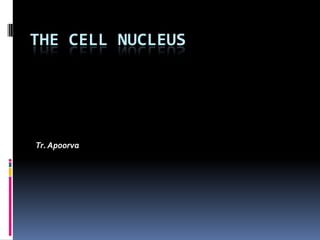
The cell nucleus
- 1. THE CELL NUCLEUS Tr. Apoorva
- 2. The Nucleus The nucleus is the headquarters of the cell. It is the most obvious organelle in any eukaryotic cell and appears as a large dark spot in EUKARYOTIC cells. It controls all cell activity.
- 3. The Nucleus is a membrane-enclosed organelle which house most of the genetic information and regulatory machinery responsible for providing the cell with its unique characteristics.
- 4. THE NUCLEUS: FUNCTIONS It stores the cell's hereditary material, or DNA. Site of DNA replication Site of DNA transcription to mRNA Ribosomal formation Nucleolus: RNA & protein required for ribosomal synthesis It coordinates the cell's activities, which include growth, intermediary metabolism, protein synthesis, and reproduction (cell division) by regulating gene expression.
- 5. THE NUCLEUS: STRUCTURE The contents of the nucleus are enclosed by a complex nuclear envelope. Included within the nucleus are: 1- Chromatin 2- Nucleoplasm/ Nuclear matrix 3- Nucleolus (concentrated area of chromatin, RNA and proteins)
- 6. NUCLEUS
- 7. nuclear envelope nucleolus nuclear pores chromatin
- 9. The NUCLEAR ENVELOPE (NE) The nuclear envelope completely encloses the nucleus and separates the cell's genetic material from the surrounding cytoplasm, serving as a barrier to prevent macromolecules from diffusing freely between the nucleoplasm and the cytoplasm.
- 10. The NE consists of two cellular membrane, an inner and an outer membrane, arranged parallel to one another and separated by 10 to 50 nanometers (nm). The outer nuclear membrane is continuous with the membrane of the rough endoplasmic reticulum (RER), and is similarly studded with ribosomes. The space between the membranes is called the perinuclear space and is continuous with the RER lumen.
- 12. The inner surface of the NE is bound to a thin filamentous network (lamins polypeptides) called the nuclear lamina. It provides mechanical support to the NE and seeves as sites for attachment for chromatin fibers. Mutations in the lamin genes are responsible for several distinct human diseases (e.g. a rare form of muscular dystrophy).
- 13. THE NUCLEAR PORE The nuclear pores are the gateways across which movement of RNAs and proteins takes place between the nucleus and cytoplasm in both direction. Proteins synthesized in the cytoplasm cross the nuclear envelop to initiate replication and transcription of genetic material. Similarly, mRNA,tRNA and ribosomal subunits built in the nucleus cross through the nuclear pores to the cytoplasm.
- 14. The pore is 100 nm in total diameter and consists of around 100 proteins which allows the free passage of small water-soluble molecules while preventing larger molecules, such as DNA and proteins. The nucleus of a typical mammalian cell has about 3000 to 4000 pores throughout its envelope.
- 15. CHROMATIN The interphase chromosomes is present in a highly extended nucleoprotein fibers called chromatin. Chromatin is the complex of DNA,RNA and protein (Histones and Non-Histomes) that makes up chromosomes. Each unreplicated chromosome contains a single continuous DNA molecule. The mitotic chromosome represents a highy condensed structure (10000:1)
- 16. chromatin chromosome
- 18. Replicated chromosome P arm kinetochore centromere Q arm sister chromatids
- 19. Each human somatic cell contains 23 pairs of different chromosomes ( DIPLOID CELLS) . GAMETES (sperm and egg cells) have one set of 23 chromosomes ( HAPLOID CELLS). One member of each pair is derived from the individual's father, and the other member is derived from the mother. One of the chromosome pairs consists of the sex chromosomes.
- 20. In normal males, the sex chromosomes are a Y chromosome inherited from the father and an X chromosome inherited from the mother. Two X chromosomes are found in normal females, one inherited from each parent. The other 22 pairs of chromosomes are termed autosomes. The members of each pair of autosomes are said to be homologs, or homologous, because their DNA is very similar. The X and Y chromosomes are not homologs of one another.
- 21. Human Chromosomes Chromosomes are the physical carriers of genetic information. The packaging of DNA into chromosomes involves several orders of DNA coiling and folding.
- 22. LEVELS OF CHROMATIN ORGANIZATION The structure of chromatin varies considerably as the cell progresses through the cell cycle. The changes in structure are required to allow the DNA to be used and managed.
- 23. Chromatin Function Package DNA into a smaller volume to fit in the cell. Strengthen the DNA to allow mitosis and meiosis Serve as a mechanism to control expression.
- 26. Simplified diagram of proposed solenoid model of DNA coiling which leads to the visible structure of the chromosome.
- 27. NUCLEOPLASM The nucleoplasm is a highly viscous liquid that surrounds the chromosomes and nucleoli. Many substances such as nucleotides (necessary for purposes such as the replication of DNA) and enzymes (which direct activities that take place in the nucleus) are dissolved in the nucleoplasm.
- 28. Nucleolus : The prominent structure in the nucleus is the nucleolus. The nucleolus produces ribosomes, which move out of the nucleus and take positions on the rough endoplasmic reticulum where they are critical in protein synthesis.